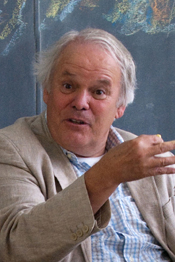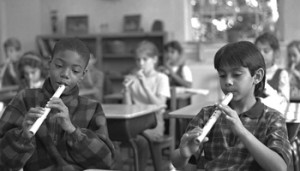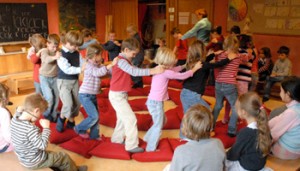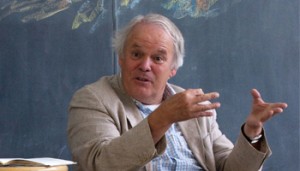Waldorf News
Rethinking the Threefold Division of the Main Lesson: Christof Wiechert

For the past ten years, Christof Wiechert has served as the head of the Pedagogical Section of the School of Spiritual Science at the Goetheanum in Dornach, Switzerland. His task has been to encourage, advise, and inspire Waldorf educators around the world. This he has done with great energy, wisdom, insight, and humor. During his tenure, Christof Wiechert has visited North America many times, lecturing at conferences, giving workshops, visiting schools and teacher education institutes. At the end of 2010, Wiechert will retire as head of the Pedagogical Section, although he will remain in Dornach and continue his work for Waldorf Education.
One of Wiechert’s recent special interests is what he calls “Waldorf myths”—concepts and practices in Waldorf Education that have little or no basis in the teachings of Rudolf Steiner and may even work against the aims of Waldorf pedagogy. In the following article, Wiechert calls into question the threefold division of the Waldorf main lesson for grades one through eight into a rhythmical part, a work part, and a storytelling part. The article is a condensed version of the original piece, first published in the Rundbrief (Journal) of the Pedagogical Section.
A New Day, Full of Promise
Each school day is a new day, a day full of promise. The first fifteen minutes of the day are very important. They set the mood for the rest of the morning and even for the whole day. The teacher has many options—have the children sing a song, practice tongue twisters, solve a riddle, clap a rhythm, recite a poem, do mental arithmetic, share experiences from outside of school. Creating the right mood should not take too long. Within fifteen minutes, the children should be ready to recite the morning verse.
The challenge of the start of the school day raises many questions that relate to the quality of the main lesson:
• What is the effect of an established daily ritual with fixed components—playing the recorder, singing a song, reciting report verses (the special verses the teacher writes for each child)?
• What is the effect of extending this rhythmic preamble to the day to thirty minutes or even forty-five minutes?
• Does a fixed and/or prolonged start of the day increase the children’s enthusiasm and ability to concentrate and learn? Or do overfamiliar activities that delay the learning of something new foster fatigue and undermine motivation?
• Does the storytelling part have to immediately follow the work part? Does this leave enough time for the children to absorb what they have learned?
• Does the threefold structure of the main lesson deprive the Waldorf class teacher of freedom and the opportunity for spontaneity and innovation?

In Rudolf Steiner’s lectures on education and in the accounts of his meetings with teachers of the first Waldorf school, there is no mention of a necessary division of the main lesson into three distinct parts. The importance of rhythm is affirmed many times. But the critical question is: Does this threefold structure lead to rhythm or merely to routine?
If this three-part structure is not based on indications by Steiner, it can still be valid if it helps the children to concentrate, or wakes them up, or lets them breathe. According to experience, though, reciting poems, singing, and dividing the main lesson do not necessarily create true rhythm and do not bring these effects. Rhythm arises only through the way in which the teacher teaches.
Time of Day, Time, and the Forming of Habits
Rudolf Steiner suggested that the early morning should be used for learning, the late morning for subjects that are based on repetition, and the afternoon for artistic activities. Hence, the main lesson typically takes place in the first part of the morning.
In the first part of the morning, we—teachers as well as children—are different beings than at other times of the day. In the morning we are more receptive, more open for what comes, but in an active way. By the afternoon, the senses are already flooded with impressions. In the evening, this receptivity is quieter, less active. The teacher must use the period of receptivity early in the day quite exactly. A half-hour later or earlier can make a big difference.
The teacher can treat time as a constant, with a linear course through the day, or as a quality. In the former case, the teacher—and the pupils too—will quickly become tired. In the latter, time will become the pulsation between concentration and relaxation. This can become rhythm, not through the routine of a structure, but through the teacher letting the pulse of time breathe through each activity in tension, then relaxation, focusing on a point, then expanding and differentiating it—in other words, through breathing in and breathing out. The teacher becomes an artist of time, if he uses time in this way.
 Finding Equilibrium: The Teacher’s Task
Finding Equilibrium: The Teacher’s Task
To a large extent it is a question of the teacher finding equilibrium. Just as in the experience of music there is an equilibrium between tension and the easing of tension, quiet and loud, fast and slow, high and low, in teaching also there must be an alternation between poles and a balance between them. If the teacher achieves this, the children’s will to learn, their desire to learn, as well as their good learning habits will be fostered. If this equilibrium is not present, what is done on a daily basis with the intention of forming good habits, turns into an empty ritual.
If the teacher fails to achieve this dynamic equilibrium, she can become dominated by the dictates of established but not living ritual. The freedom and spontaneity of the classroom community will have vanished. This leads to unrest in the children’s souls, because in the morning they have come in the mood for learning, not for going through a hollow ritual.
In this context, some common rhythmic activities can be called into question. The rhythmic section becomes ritualistic when, for example, in a sixth-grade class each student recites his personal report verse in front of the class on the day of the week on which he was born. As such, the custom is not bad. However, it can easily become an empty ritual, especially if the verse was written by the teacher months before and is no longer relevant. Then we see an empty ritual: a totally unengaged pupil reciting his verse in front of his bored classmates. The procedure is of no value to anyone. And it takes time, easily ten to fifteen minutes in a larger class. If you add in the remaining elements of this part of the morning, truly precious time has been lost.
I also dare to question whether playing the recorder in the first part of the morning is an appropriate activity. There is a great difference to be noted between a group of children who play the recorder in the early morning and a group of children who do this in the music lesson later in the morning. This difference, strangely enough, is not observed with singing.
And how about the much-praised stamping of the feet? What does that achieve? It makes the children tired instead of awake.
The real rhythm to which we should always pay attention is not in the structure of the main lesson, but is rather the rhythm that reveals itself in the children. When do they get tired, when do they wake up? That is the essential consideration. If we are sensitive to this, many discipline problems will be resolved.
It is easy to grasp this point from the understanding of the human being as presented by Rudolf Steiner. Everything that we do with our bodies, that we do through the will to be active—moving about, dancing around in a circle, stamping with our feet, clapping—all these activities are spiritual in nature. Each is achieved by a thought, which changes “magically” into a movement. Thus, Steiner describes gymnastics as the most spiritual subject!
In contrast, Steiner describes intellectual activity as physical, because we use the brain, and all processes are within the body. This stimulation, by thought, of the physical body makes us awake.

The peculiarity of a spiritual activity such as movement is that one is not in it with one’s waking consciousness. We sleep in our wills. When I make a certain movement with my body I do not think, “Well, now I must contract these three muscles just so much and relax those other two muscles just so much.” No, I just do the movement unconsciously. This is why these activities make us tired.
The idea is widespread that you stamp around vigorously with a group of children in order to wake them up. In fact, the stamping has the opposite effect. You can observe this also in the practicing of the times tables when it is linked to movements such as stepping and clapping. Then you will see the pupils carrying out the procedure “as in a dream.” They speak in a chorus, and a kind of “trance” ensues. The activity is carried out as if in sleep. Teachers will do well to lose no time in breaking the link between this movement in sleep and knowledge gained through wakefulness.
The rhythmic part is followed by the “work” or academic part of the main lesson, in which the student takes in what comes from the teacher. If the teacher imbues the work part and in fact the whole morning with a rhythm, with a breathing in and breathing out, then the actual rhythm part need not be long. And if the work part is thus made alive, it makes little difference how long it lasts. It can take an hour or be longer or shorter. Whatever the length, the rhythmic aspect will support the students in their learning. What is most important in the end is that every pupil take home the experience that he has learned a lot. This feeling is the most essential part of the main lesson.
The Story
The story told at the end of the main lesson is a cherished and universal aspect of Waldorf Education. But a story begun in the early part of the main lesson and continued in the final quarter can also be a blessing for the class. It is a blessing, though, only when the students have the feeling—unconscious or semiconscious—that they have worked so hard that there is just enough time for a story. If too little has been done before this point, the pupils’ inner experience is: “We have only just started to learn something and now it is all over.” This thought is mostly unconscious but will manifest as restlessness. Then the story has a disturbing effect.
Here we have an example of a time rhythm. Every activity has its own proper time. What is the right moment, the “kairos,” for storytelling? The story need not be at the end of the main lesson. It can fit elsewhere into the course of the day. If the class teacher has a lesson at the end of the school day with his own class, that period is ideal timing for the storytelling. It is splendid to close the school day with a story.
Teachers should be aware how many stories the children are told in the course of a week. The students may be listening to stories in handwork or in language class as well as in the main lesson. This matter should be discussed in meetings of the faculty.
Children may be exposed to too many tales and stories. In intellectual activities, the pupil’s “ego” connects with his or her body. The ego “settles.” In imaginative and pictorial activities, the ego loosens itself from the body. This is a rhythm specific to Waldorf Education, seeing to it that the processes of the ego, connecting with and loosening itself from the body, are in the right relationship to one another. If the former activity is too strong, the ego becomes a prisoner of the body. Then, the needs of the body dictate life. If the second activity is too strong, the body loses its bearings. Life is exhausted through unfulfilled wishes and ideals that are never realized.
Waldorf Education and Self-Examination
It is important that we within the Waldorf movement examine and assess how we practice Waldorf Education. If there are elements that need to be changed or eliminated, researchers from outside the movement will sooner or later identify and criticize them.
For example, a recent article by an external researcher describes the behavioral problems of a Waldorf student during and after the morning’s rhythmic activities: “It could be supposed that his expressive and effusive personality is inclined to manifest behavioral problems in such strongly formed, ritualized, collective activities.”
This observation and appraisal from the outside raises a fundamental issue. If the Waldorf movement does not examine and take a critical look at its own educational practices, science will do it instead. And it is already doing so. It would certainly be better if this capacity for critical dialogue would be exercised within the school movement beforehand.
I have tried to show that the threefold structure does not belong to the essential characteristics of Waldorf Education. On the contrary, it can be a hindrance to the development of a teacher-pupil relationship that breathes between teaching and learning.
After over ninety years of Waldorf Education, we need to examine the way it has developed in order not to damage it, but rather to renew it and reinvigorate ourselves. I have formed the conviction through the years that the source, or spring, of renewal lies in the original indications and intentions of Rudolf Steiner. If this spring begins to bubble up in us, we will become viable for the future. The possibility will then arise of not having to make a lot of unnecessary diversions. Something new does not need to be taken hold of just because of its newness, and innovations need not be retained if they fail to provide results.
However, time marches on. If we do not ourselves undertake this renewal through the questioning of our teaching habits, some of which may have no basis in the origins of Waldorf Education, others will do it for us. The only unfortunate thing about the observation cited above is that we did not make it ourselves. Such research should be a stimulus to our own self-examination.
Original translation by John Weedon
Adaptation, condensation and introduction by Ronald E. Koetzsch
The full text can be found at the AWSNA website: www.whywaldorfworks.org
 Middle School Science With Roberto Trostli
Middle School Science With Roberto Trostli Train to Teach in Seattle
Train to Teach in Seattle Immersive Academics and Arts
Immersive Academics and Arts Waldorf Training in Australia
Waldorf Training in Australia Space speaks. Its language is movement.
Space speaks. Its language is movement. Waldorf-inspired Homeschool Curriculum
Waldorf-inspired Homeschool Curriculum Bay Area Teacher Training
Bay Area Teacher Training Full-Time Teacher Education
Full-Time Teacher Education Flexible preparation for your new grade
Flexible preparation for your new grade
 Jamie York Books, Resources, Workshops
Jamie York Books, Resources, Workshops Transforming Voices Worldwide
Transforming Voices Worldwide Bringing Love to Learning for a Lifetime
Bringing Love to Learning for a Lifetime Great books for Waldorf Teachers & Families
Great books for Waldorf Teachers & Families ~ Ensoul Your World With Color ~
~ Ensoul Your World With Color ~ Quality Education in the Heartland
Quality Education in the Heartland Roadmap to Literacy Books & Courses
Roadmap to Literacy Books & Courses Summer Programs - Culminating Class Trips
Summer Programs - Culminating Class Trips Apply Today: New Cohort Starts Nov. 2025
Apply Today: New Cohort Starts Nov. 2025 Caring for All Stages of Life
Caring for All Stages of Life Everything a Teacher Needs
Everything a Teacher Needs The Journey is Everything
The Journey is Everything Association for a Healing Education
Association for a Healing Education RSS Feeds
RSS Feeds